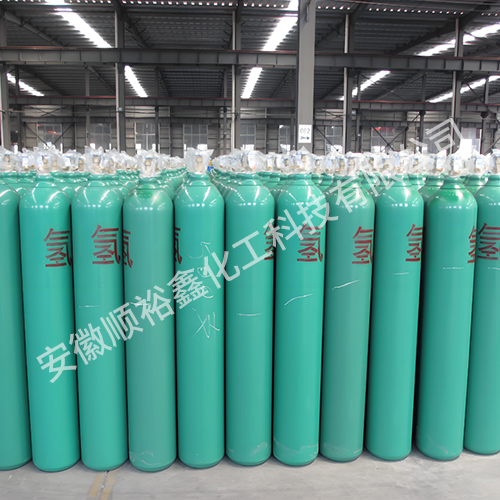Hydrogen
2024/6/6
![]()
Chinese Name: 氢气
Chemical Formula: H2
Hydrogen technical indicators
|
Components/Impurities |
Hydrogen/4.0N |
Hydrogen/5.0N |
Hydrogen/6.0N |
|
Hydrogen content |
0.9999 | 0.99999 | 0.999999 |
| O2 | ≤5ppm | ≤1ppm | ≤0.2ppm |
| N2 | ≤60ppm | ≤5ppm | ≤0.4ppm |
| CO | ≤5ppm | ≤1ppm | ≤0.1ppm |
| CO2 | ≤5ppm | ≤1ppm | ≤0.1ppm |
|
Methane |
≤10ppm | ≤1ppm | ≤0.2ppm |
| H2O | ≤10ppm | ≤3ppm | ≤0.5ppm |
Types of hydrogen packaging
|
Types of steel cylinders |
Pressure |
Gas volume |
Net weight of gas |
| 50Lsteel cylinders | 19.5±0.5MPa | 10000L | 0.8kg |
| 40Lsteel cylinders | 13.5MPa | 5400L | 0.45kg |
1、Basic physical properties
Color and odor:Hydrogen is typically a colorless and odorless gas.
Density:Hydrogen has a very low density and is the smallest molecular weight gas in nature.Under standard conditions(0℃and 101.325 kPa),the mass of 1 liter of hydrogen is approximately 0.089 grams,which is about 1/14 of the air density.
Solubility:Hydrogen is difficult to dissolve in water,which allows it to be collected using drainage and gas collection methods.At 20℃,a maximum of 1.82 mL of hydrogen can be dissolved in 100 mL of water.
Liquefaction and solidification:At-252.8℃,hydrogen can turn into a colorless liquid,while at-259.2℃,it can turn into a snowflake like solid.
Permeability:Due to the small molecular weight of hydrogen,it has strong permeability and can pass through rubber and latex tubes at room temperature,but can pass through metal films such as palladium,nickel,and steel at high temperatures.
These physical properties give hydrogen unique advantages in many applications,such as as as a high-energy fuel,hydrogen oxygen flame welding,and metal cutting.
2、Hydrogen source
(1) Natural sources
Mantle degassing:There is abundant hydrogen in the mantle or core of the Earth's interior,which can be gradually released to the surface through geological movements.
Serpentine petrification:When water reacts with iron rich ultrabasic rocks,hydrogen gas is produced.This reaction is common near plate boundaries,such as mid ocean ridges,transition faults,and subduction zones.
Water splitting:The energy released by radioactive elements(such as uranium,thorium,and potassium)in the Earth's crust during radioactive decay can break down water molecules into oxygen and hydrogen.
Biogenesis:Hydrogen gas is generated through anaerobic decomposition,fermentation,and nitrogen fixing bacteria of organic matter.Although hydrogen is a highly reducing gas that is easily oxidized,certain microbial metabolic processes can produce hydrogen.
Fault Friction:During fault activity,the energy generated by friction may cause chemical bonds in surrounding rocks to break,resulting in the formation of hydrogen gas.
Hydroxyl decomposition in mineral lattice structure:Under certain conditions,hydroxyl groups in certain mineral lattices can decompose to produce hydrogen gas.
Organic matter decomposition:The decomposition of organic matter underground under specific conditions may also produce hydrogen gas.
(2) Manual preparation method
Electrolysis of water to produce hydrogen:One of the most common preparation methods is to produce hydrogen through electrolysis of water.Electrolysis of water for hydrogen production often uses a series of electrolytic cells with iron as the cathode surface and nickel as the anode surface to electrolyze aqueous solutions of caustic potassium or caustic soda.This method has a high cost,but the product purity is high,and it can directly produce hydrogen with a purity of over 99.7%.
Hydrogen production from mineral fuels:producing hydrogen from coal,oil,and natural gas as raw materials.Although this method has some impact on the environment,it will still play an important role in the future due to its mature technology.
Industrial by-product hydrogen production:such as hydrogen production from by-products of synthetic ammonia plants,with low cost and high output.
Biomass hydrogen production:Using biomass materials to produce hydrogen through chemical reactions.
Solar hydrogen production:Using solar energy to produce hydrogen through photoelectrochemical or photocatalytic methods is an environmentally friendly way of hydrogen production.
3、Main purpose
Hydrogen,as an important industrial raw material,has the following main uses:
(1) Synthetic ammonia:Hydrogen is the main raw material for synthetic ammonia,which is used as fertilizer in agriculture and in industry to produce nitric acid,soda ash,etc.
(2) Petroleum refining:Hydrogen is used in the process of petroleum refining for steps such as hydrocracking and hydroprocessing to increase the production and quality of fuels such as gasoline.
(3) Fine Chemicals:Hydrogen is used in the chemical industry to produce chemicals such as methanol,formaldehyde,and polyethylene.
(4) Fuel:Hydrogen,as a clean energy source,can be used for fuel cell vehicles,rocket engines,etc.
(5) Metallurgical industry:Hydrogen is used in the refining and welding processes of metals,which can remove oxides from metals and improve their purity.
(6) Electronics industry:Hydrogen is used as a carrier gas and protective gas in semiconductor production to prevent oxidation of semiconductor devices.
(7) Lighting:Hydrogen gas filled into light bulbs can generate very high temperatures and brightness,used for professional lighting.
(8) Energy storage:Hydrogen,as an energy carrier,can be produced through methods such as electrolysis of water and converted into electrical energy through fuel cells when needed.
(9) Cooling:Liquid hydrogen is used as a coolant in superconducting magnets,particle accelerators,and other fields.
(10) Maglev train:Hydrogen can be used for the propulsion system of maglev trains.
Hydrogen has important applications in meteorological balloons.Due to its lower density than other common gases,hydrogen is chosen by meteorologists for use in high-altitude weather balloons.This lightweight feature allows balloons to easily ascend to high altitudes for meteorological observation and measurement.In addition,this characteristic of hydrogen also reduces the resistance experienced by balloons during ascent,improving the accuracy and efficiency of observations.
- Related information
Anhui Shunyuxin Chemical Technology Co.,Ltd. Copyright disclaimer

